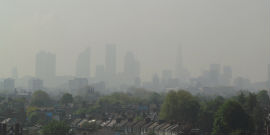Calls for more research to test the accuracy of low-cost air pollution monitors
Posted on 7 July 2016
 Air pollution over London
Air pollution over London
Professor Alastair Lewis and Dr Peter Edwards call on researchers to test the accuracy of low-cost monitoring devices before regulators are flooded with questionable air quality measurements.
The public is increasingly aware of the health and economic costs of air pollution. Poor air quality is linked to over three million deaths each year, and 96 per cent of people in large cities are exposed to pollutant levels that are above recommended limits.
The costs of urban air pollution amount to two per cent of gross domestic product in developed countries and five per cent in developing countries.
Media attention and the increasing availability of data are reinvigorating efforts in many countries to tackle air pollution, driven as much by local and national politics as by science.
For regulatory purposes, governments and scientists use the most accurate, but expensive, detectors.
And although the interpretation of the data is a subject of lively debate, the quality of readings is rarely questioned. By contrast, few of these low-cost devices have been rigorously tested.
Writing a comment piece in the journal Nature, the academics say: “The research and regulatory communities are behind the curve.
“The penetration of these devices into the public domain, generating large volumes of untested and questionable data available to all, is inevitable and will increasingly become a headache for those who are responsible for managing air quality.
“Although we do not wish to stifle innovation, sensors that claim to be able to measure ambient pollution levels could be required to undergo an independent testing regime, as is the case for instruments that are used in regulatory measurements.
“The academic air pollution community must engage to ensure that it does the hard yards in the lab and field on calibration and testing.
“It must also find ways to overcome some measurement challenges. Researchers should take the lead on evaluating sensor performance, creating better devices and designing research applications that are suited to the quantified capabilities of sensors.”
Alastair Lewis is Professor of atmospheric chemistry at the University of York. Dr Pete Edwards is a research fellow in the Wolfson Atmospheric Chemistry Laboratories at the University of York.
Further information:
Explore more news

Character from unfinished Jane Austen novel reimagined in special portrait
Thursday 31 July 2025

“Window of opportunity” to address heritage concerns of Cambridgeshire rail project, say researchers
Tuesday 29 July 2025

Poor diets fuelling health crisis in the North, report reveals
Wednesday 23 July 2025

Nightjars at real risk from decreasing genetic diversity, researchers warn
Tuesday 22 July 2025

A ‘millet mystery’ in ancient Japan reveals a complex picture of agricultural adoption, research shows
Monday 21 July 2025
